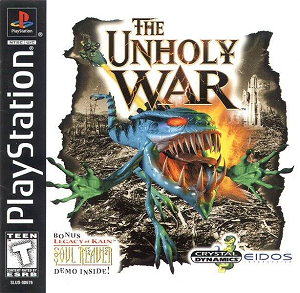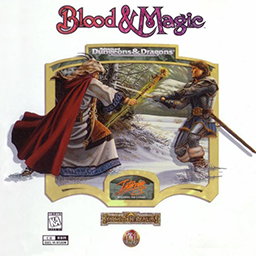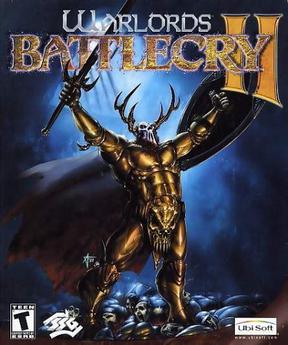
King's Bounty is a turn-based fantasy video game designed by Jon Van Caneghem and published by New World Computing in 1990. The game follows the player's character, a hero of King Maximus, appointed with the job of retrieving the Sceptre of Order from the forces of chaos, led by Arech Dragonbreath. King's Bounty is notably considered the forerunner of the Heroes of Might and Magic series of games.
Geneforge is the first video game in the Geneforge series of role-playing video games created by Spiderweb Software.

Age of Wonders is a 1999 turn-based strategy game co-developed by Triumph Studios and Epic MegaGames, and published by Gathering of Developers.

Master of Magic is a single-player, fantasy turn-based 4X strategy game in which the player plays as a wizard attempting to dominate two linked worlds. From a small settlement, the player manages resources, builds cities and armies, and researches spells, growing an empire and fighting the other wizards.

Shogun: Total War is a turn-based strategy and real-time tactics video game developed by The Creative Assembly and published by Electronic Arts for Microsoft Windows personal computers. Released in June 2000, the game became the debut title in The Creative Assembly's Total War series. Set in Japan during Sengoku jidai—the "Warring States" period from the 15th to the beginning of the 17th century—the game has players adopt the leader of a contemporary Japanese clan, attempt to conquer the nation and claim the position of shōgun. The turn-based aspect of the game focuses on a map of Japan where military force, religion, diplomacy, espionage and economics all influence the player's actions, whilst battles are fought in a 3D real-time mode.

Might and Magic Book One: The Secret of the Inner Sanctum is an early role-playing video game, first in the popular and influential Might and Magic franchise. It was released in 1986 as New World Computing's debut, ported to numerous platforms and re-released continuously through the early 1990s.
Warlords is a video game series created by Steve Fawkner, in which role-playing elements are combined with turn-based strategy in a fantasy setting. The series began with Warlords in 1990 and includes three other games, two expansion packs, and several spinoffs.

Beyond Zork is an interactive fiction computer game written by Brian Moriarty and released by Infocom in 1987. It was one of the last games in the Zork series developed by Infocom. It signified a notable departure from the standard format of Infocom's earlier games which relied purely on text and puzzle-solving: among other features, Beyond Zork incorporated a crude on-screen map, the use of character statistics and levels, and RPG combat elements.

Warlords IV: Heroes of Etheria is a turn-based strategy video game developed by Infinite Interactive and published by Ubi Soft. It is the fourth in the Warlords series.

Chaos: The Battle of Wizards is a turn-based tactics video game released for the ZX Spectrum in 1985. It was written by Julian Gollop and originally published by Games Workshop. Based on Gollop's 1982 design for a board game / card game hybrid, Chaos received a positive reception and went on to influence various games, including Darwinia and King's Bounty, and spawned a sequel, Lords of Chaos, in 1990.

The Unholy War is a PlayStation video game developed by Toys for Bob and published by Eidos Interactive. It is a fighting game in which characters fight in a 3D environment using melee and projectile attacks. The game came with a demo of Legacy of Kain: Soul Reaver.

Greyhawk Wars is a fantasy board wargame that was published by TSR, Inc. in 1991. The game was designed by David Cook as a strategic simulation of the eponymous Greyhawk Wars on the fictional world of Oerth, the World of Greyhawk campaign setting for the Dungeons & Dragons role-playing game.

Blood & Magic is a real-time strategy video game released by Interplay Productions in 1996 which uses the Dungeons & Dragons license.

Lords of Magic is a turn-based strategy Microsoft Windows game designed for Windows 95/98 by Sierra On-Line. The game was intended to combine elements of Heroes of Might and Magic II and Lords of the Realm II. The special edition also contains the Legends of Urak quest pack, a set of five individual quests that revolve around stories unrelated to the main plot of the game.

The Lord of the Rings: War of the Ring is a 2003 real-time strategy game (RTS) developed by Liquid Entertainment and published by Sierra Entertainment, a subsidiary of Vivendi Universal Games. Set in J. R. R. Tolkien’s fictional Middle-earth, it expands upon the events of the War of the Ring as told in his fantasy novel, The Lord of the Rings.

Dominions 3: The Awakening is a fantasy turn-based strategy game created by Illwinter and published in 2006 by Shrapnel Games. It is the third game in the Dominions series, preceded by Dominions: Priests, Prophets and Pretenders and Dominions II: The Ascension Wars. Illwinter's publishing contract with Shrapnel Games expired in November 2012 and Dominions 3 was republished on Desura in late December 2012 and soon after on GamersGate. Dominions 3 went through the Greenlight process and was released on Steam in September 2013.

Warlords Battlecry II is a real-time strategy and role-playing game, developed by Strategic Studies Group (SSG) as the sequel to Warlords Battlecry. It was released on March 12, 2002. The game requires the player to build buildings and create units in order to defeat the enemy, while sending their hero on optional quests.

Magic: The Gathering is a video game published by MicroProse in March 1997 based on the collectible card game Magic: The Gathering. It is often referred to as Shandalar after the plane of Shandalar, where the game takes place. The player must travel the land and fight random enemies to gain cards, and defeat five wizards representing the five colors. The player must prevent one color from gaining too much power, and defeat the planeswalker Arzakon, who has a deck of all five colors. Adventure and role-playing elements are present, including inventory, gold, towns, dungeons, random battles, and character progression in the form of new abilities and a higher life point total. An oversized version of Aswan Jaguar was included in the game box.

Universe: The Role-Playing Game of the Future is a science fiction role-playing game published by Simulation Publications, Inc (SPI) from 1981 to 1983. It was praised for its innovative and tightly organized rules for such sci-fi RPG concerns as generating planets, applying character skills to in-game situations, and resolving the initial moments of alien encounters; however, it was also criticized for its cumbersome encounter/combat system and its lack of compelling background material. Universe was also noted for its "striking" Interstellar Display, a poster-sized, astronomically accurate map of all stars within 30 light-years of Earth.

Combat Mission is the name of a series of computer wargames simulating tactical battles. The series has progressed through two distinct game engines. The original game engine, referred to as 'CMx1' by the developer, Battlefront.com, powered a trio of games set in the Second World War. Combat Mission: Shock Force was released in July 2007 as the debut of the 'CMx2' game engine. The Combat Mission games are a mixture of turn-based gameplay and simultaneous real-time execution. The game environment is fully three-dimensional, with a "Wego" style of play wherein each player enters their orders into the computer simultaneously during pauses in the action, and then are powerless to intervene during the action phase. More familiar turn-based games use an "I-go/You-go" system of play.

















